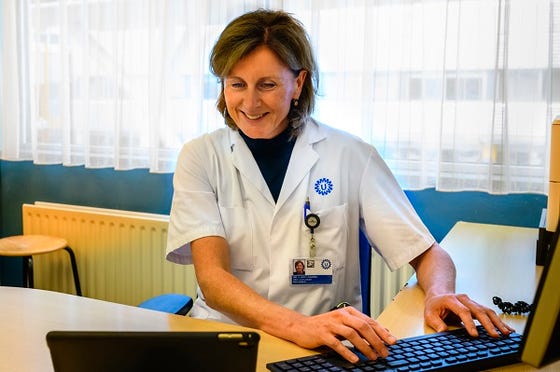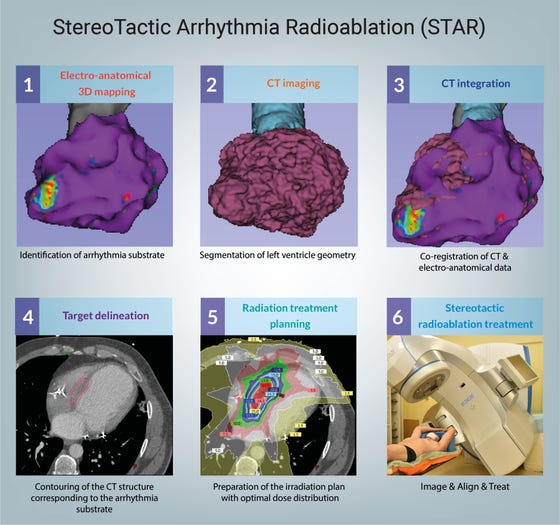For Doctors

STOPSTORM consortium is the acronym for “Standardized Treatment and Outcome Platform for Stereotactic Therapy Of Re-entry tachycardia by a Multidisciplinary” consortium.
Patients with ventricular tachycardia (VT) are generally treated with antiarrhythmic drugs, catheter ablation and Implantable Cardioverted-Defibrillators (ICD) in order to reduce VT burden and prevent sudden death from a VT episode. Nevertheless, failures of common treatments, and recurrences of VT after catheter ablation remain a significant concern, especially with growing number of patients worldwide.
Stereotactic arrhythmia radioablation (STAR), is the application of highly focused radiation doses to the region of VT substrate, and was clinically introduced in 2012. The effect of STAR has been explored in several pre-clinical studies with varying methods and outcomes and has recently demonstrated the potential to significantly reduce the burden of arrhythmia in VT patients without further treatment options. Details on STAR are summarized in several well-written pre-clinical, clinical and technical reviews [1-6].

StearoTactic Arrhythmia Radioablation (STAR) Procedural workflow. CT-computed tomography. Image provided with permission by Marcin Miszczyk 2021 [2]
The experience for STAR in VT patients is still limited but steadily and quickly growing through numerous single center and multi-center clinical trials performed at pioneering centers. The main inclusion criteria for STAR are considered to be a structural heart disease and the experience of repeated symptomatic monomorphic VT with adequate ICD intervention under optimized antiarrhythmic medication and prior (failed) catheter ablation, however it may vary from center to center and country to country.
The STOPSTORM project aims at harmonizing and focusing the efforts to explore the potential of STAR in Europe, and summarizing all ongoing clinical trials under one registry database. If you would like to refer or evaluate a possible VT patient or participate in the STOPStorm registry efforts, please do not hesitate to contact our Project Manager at stopstorm@umcutrecht.nl and they will put you in touch with your closest STOPStorm consortium member center.
[1] van der Ree MH, Blanck O, Limpens J, et al. Cardiac radioablation-A systematic review. Heart Rhythm. 2020;17(8):1381-1392. https://doi.org/10.1016/j.hrthm.2020.03.013
[2] Miszczyk M, Jadczyk T, Gołba K, et al. Clinical Evidence behind Stereotactic Radiotherapy for the Treatment of Ventricular Tachycardia (STAR)-A Comprehensive Review. J Clin Med. 2021;10(6):1238. https://doi.org/10.3390/jcm10061238 (Open Access)
[3] Jumeau R, Ozsahin M, Schwitter J, et al. Stereotactic Radiotherapy for the Management of Refractory Ventricular Tachycardia: Promise and Future Directions. Front Cardiovasc Med. 2020;7:108. https://doi.org/10.3389/fcvm.2020.00108 (Open Access)
[4] Whitaker J, Mak RH, Zei PC. Non-invasive ablation of arrhythmias with stereotactic ablative radiotherapy. Trends Cardiovasc Med. 2021:S1050-1738(21)00052-9. https://doi.org/10.1016/j.tcm.2021.04.008
[5] Blanck O, Buergy D, Vens M, et al. Radiosurgery for ventricular tachycardia: preclinical and clinical evidence and study design for a German multi-center multi-platform feasibility trial (RAVENTA). Clin Res Cardiol. 2020;109(11):1319-1332. https://doi.org/10.1007/s00392-020-01650-9 (Open Access)
[6] Lydiard PGDip S, Blanck O, Hugo G, et al. A Review of Cardiac Radioablation (CR) for Arrhythmias: Procedures, Technology, and Future Opportunities. Int J Radiat Oncol Biol Phys. 2021;109(3):783-800. https://doi.org/10.1016/j.ijrobp.2020.10.036

